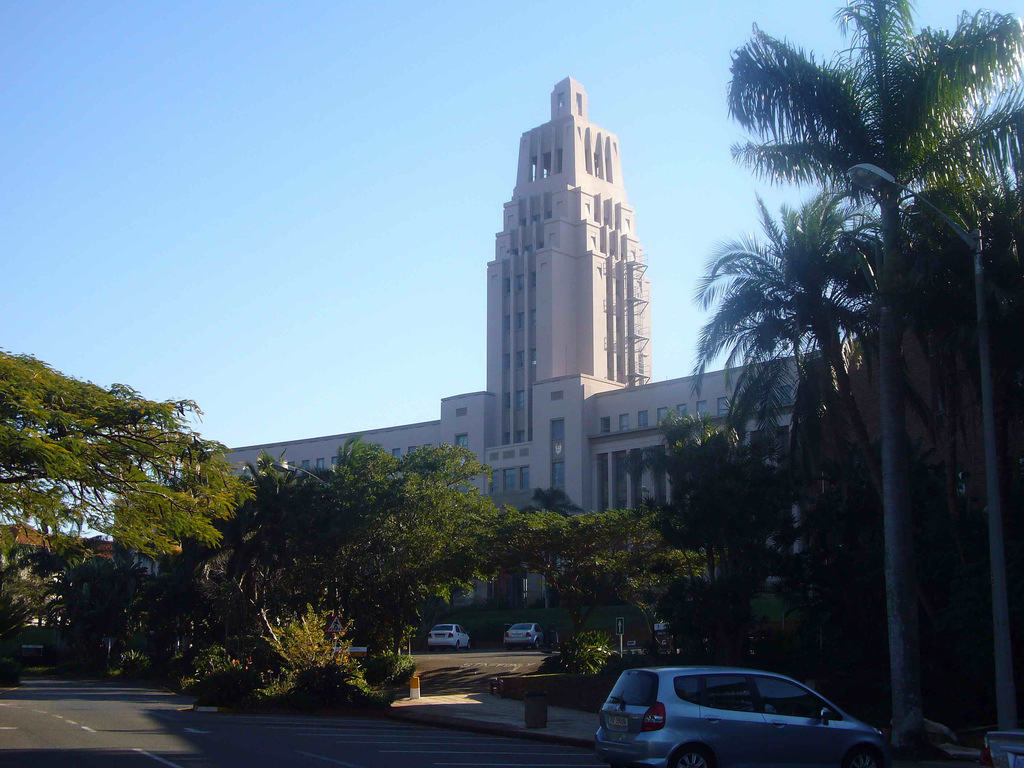|
Uthongathi School
uThongathi School was a high school near oThongathi, KwaZulu-Natal, South Africa. The school opened in January 1986. The school was the first nonracial school established by the New Era Schools Trust (NEST). It opened with 107 pupils of all races. Addressing the first assembly of the school the principal, Mr Richard Thompson, said: "Today we are the only school in South Africa which is truly nonracial. The whole of South Africa will be watching us very carefully because we are doing something completely new. Today we are starting a new era in education in South Africa. A school where the colour of your skin is completely unimportant. We are trying to set an example for South Africa and we want to prove that this is how education must be, if South Africa is ever going to be a peaceful country." The campus was bought by Graeme Crawford in 1997 and a new school named Crawford College, North Coast Crawford College, North Coast schoolalternative, independent school between Ballito ... [...More Info...] [...Related Items...] OR: [Wikipedia] [Google] [Baidu] |
Tongaat
oThongathi (previously and popularly known as Tongaat) is a town in KwaZulu-Natal, South Africa, about north of Durban and south of KwaDukuza. It now forms part of eThekwini Metropolitan Municipality, or the Greater Durban area. The area is home to the oldest Indian community in South Africa, having been where the first indentured Indian laborers settled in 1860 to work in the sugar-cane plantations. Much of the architectural style in the town was the work of Ivan Mitford-Barberton, and many buildings are in the Cape Dutch style of architecture. History oThongathi was established as Tongaat in 1945 and its name was taken from the name of the uThongathi River which passes by the town: The name of the river, derived from Zulu, is said to mean In 2017 plans were made for the restoration of the historic railway station building. Name change In November 2009, the eThekwini Metropolitan Municipality submitted a list of places in the municipality to the KwaZulu-Natal Provincial Geog ... [...More Info...] [...Related Items...] OR: [Wikipedia] [Google] [Baidu] |
KwaZulu-Natal
KwaZulu-Natal (, also referred to as KZN and known as "the garden province") is a province of South Africa that was created in 1994 when the Zulu bantustan of KwaZulu ("Place of the Zulu" in Zulu) and Natal Province were merged. It is located in the southeast of the country, with a long shoreline on the Indian Ocean and sharing borders with three other provinces and the countries of Mozambique, Eswatini and Lesotho. Its capital is Pietermaritzburg, and its largest city is Durban. It is the second-most populous province in South Africa, with slightly fewer residents than Gauteng. Two areas in KwaZulu-Natal have been declared UNESCO World Heritage Sites: the iSimangaliso Wetland Park and the uKhahlamba Drakensberg Park. These areas are extremely scenic as well as important to the surrounding ecosystems. During the 1830s and early 1840s, the northern part of what is now KwaZulu-Natal was established as the Zulu Kingdom while the southern part was, briefly, the Boer Natalia Repu ... [...More Info...] [...Related Items...] OR: [Wikipedia] [Google] [Baidu] |
Crawford College, North Coast
Crawford College, North Coast schoolalternative, independent school between Ballito and Umdloti on the North Coast of KwaZulu-Natal KwaZulu-Natal (, also referred to as KZN and known as "the garden province") is a province of South Africa that was created in 1994 when the Zulu bantustan of KwaZulu ("Place of the Zulu" in Zulu) and Natal Province were merged. It is locate ..., South Africa. The school is owned by the ADvTECH Group and is run as a for-profit business enterprise. Crawford College, North Coast was founded in 1997 on the campus of uThongathi School by Graeme Crawford. The school comprisepre-primary and college References External links *[...More Info...] [...Related Items...] OR: [Wikipedia] [Google] [Baidu] |
University Of Natal
The University of Natal was a university in the former South African province Natal which later became KwaZulu-Natal. The University of Natal no longer exists as a distinct legal entity, as it was incorporated into the University of KwaZulu-Natal on 1 January 2004. It was founded in 1910 as the Natal University College in Pietermaritzburg and expanded to include a campus in Durban in 1931. In 1947, the university opened a medical school for non-white students in Durban. The Pietermaritzburg campus was known for its agricultural engineering programmes, hence the nickname "the farmers" whilst the Durban campus was known as "the engineers," as it concentrated on other engineering programmes. The Council of the University of Natal voted on 31 May 2002 to offer the post of Vice-Chancellor and University Principal to world-renowned medical scientist and former Medical Research Council President - Professor Malegapuru Makgoba who assumed office on the 1 September 2002. He was entrus ... [...More Info...] [...Related Items...] OR: [Wikipedia] [Google] [Baidu] |
South African Institute Of Race Relations
Established in 1929,http://www.sairr.org.za/profile/ the South African Institute of Race Relations (SAIRR) is a research and policy organisation in South Africa. The institute is "one of the oldest liberal institutions in the country". The institute investigates socioeconomic conditions in South Africa, and aims to address issues such as poverty and inequality, and to promote economic growth through promoting a system of limited government, a market economy, private enterprise, freedom of speech, individual liberty, property rights, and the rule of law. The SAIRR tracks trends in every area of South Africa's development, ranging from business and the economy to crime, living conditions, and politics. History The institute was founded in 1929. The inaugural meeting was held on 9 May 1929 in the Johannesburg home of the missionary Reverend Ray E. Phillips. In attendance were Davidson Don Tengo Jabavu, one of the first professors at the University of Fort Hare; Johannes du Ple ... [...More Info...] [...Related Items...] OR: [Wikipedia] [Google] [Baidu] |

